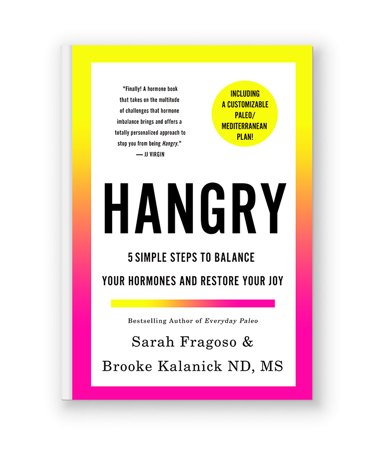
This blog is a follow up to my talk at Train Like A Girl 2, two weekends ago in Lexingon, KY.
Today, we’re digging in to stress and adrenal fatigue in detail to give you more info. If you missed it, last week I gave you two big, picture posts – just in case you don’t want this much of the nitty gritty 🙂 See here and here for those. Ready for more? Here we go:
Many of you have been told by your personal trainer or nutritionist that you have adrenal fatigue (or you strongly suspect it after reading the symptom list below!). And it’s true, oh so many of us are in this camp.
However there are a few very important points that are typically missed when talking about adrenal fatigue:

It is not truly an adrenal gland that’s “fatigued”, meaning it’s worn out and can’t do its job. Like most other hormone producing glands in your body, the adrenals respond to instructions from the brain (pituitary and hypothalamus particularly). It may be better termed “adrenal brain dis-coordination” (but that’s less catchy isn’t it??)
Essentially, your brain and your adrenals need some couples therapy cuz their communication stinks.
The best way to see this brain/adrenal dis-coordination is to do a test where saliva is collected at 4 different times during the day. This will not only assess the total output of cortisol, but what level it is at during the various times of the day. And it’s important not to merely look at cortisol but also other key adrenal hormones like DHEA, pregnenalone – and for women, of course progesterone and estrogen.

This is a perfect adrenal profile on a saliva test. I’ve never seen anything quite this lovely 🙂 This person’s output is within the normal green range throughout the day with cortisol being higher in the morning and tapering off throughout the day to be lowest at bedtime. Beautiful.

This is more often what is seen: high at the wrong times, low at the wrong times and everything in between making it hard to guess if you’re “high” or “low” cortisol.
Traditionally it was thought that you progressed through specific stages of adrenal dysfunction, working your way into adrenal fatigue. We now know that you don’t necessarily have to do these steps in order and it’s common for women to get hung up in Phase 2 (the progesterone or pregnenalone steal):
Phase 1: Alarm Phase.
Initial response of high cortisol and normal DHEA as your body tries to adapt to the demands of the high stress situation.
Phase 2: Resistance Phase.
When you’re under prolonged stress resources shift towards cortisol (this is the pregnalaone or progesterone steal I mentioned here). Cortisol is high and DHEA drops low. Women can easily get stuck here and lock into this high cortisol/low DHEA and low progesterone state.
Phase 3: Exhaustion Stage.
This is adrenal fatigue, or loss of the ability to adapt and cope with stress. Cortisol can be overall high or low cortisol and DHEA is still in the tank. In the past, this stage was thought of as “normal cortisol and low DHEA” but we know now as the stress continues, cofactors that make cortisol become depleted and body switches out of pregnenolone steal and shunts pregnenolone back to DHEA (low cortisol and normal DHEA).
Get you FREE copy of my Guide To Lab Testing & Your Hormones
This guide covers hormonal testing and thyroid patterns and will show you how to suss out the Hormonal Dealbreakers of inflammation, anemia and blood sugar problems.
Get Your Free Lab Guide HereSo Dr Brooke, Do I Have Adrenal Fatigue?
Without testing, it can be tough for you to simply use your symptoms to assess if you are low or high cortisol because:
- Cortisol can be high and low in the same day. Many have low morning and high evening; overall low but spike high in response to stresses like a workout, and everything in between.
- Timing and rhythm of cortisol output are as important as total output – whether or not you’re simply “high or low”. This is one reason why saliva is more useful than morning cortisol or even a 24 hour cortisol for seeing functional adrenal issues.
That said, if you’ve been stressed or sick, don’t cope well with stress or just generally feel run down – well you might indeed have adrenal fatigue.

Take a look at these symptoms, I’ll bet most of you can relate:
- Fatigue (the most common symptom)
- Headaches with mental or physical stress OR afternoon headaches
- Weak immune system
- Allergies
- Slow started in the morning
- Ulcers
- Feel full or bloated (various digestive symptoms)
- Crave sweets or stimulants (caffeine)
- Blurry vision
- Unstable mood
- Shakey or lightheaded between meals
- Irritable before meals
- Eating relieves fatigue
- Can’t stay asleep or can’t fall asleep
Trouble is many of these can also be symptoms of insulin resistance or hypothyroidism, particularly: fatigue, slow starter in the morning, crave sweets or stimulants (caffeine), unstable mood and sleep disturbances. And of course you can have adrenal, insulin and thyroid problems at the same time.
Order Hangry right now!
If you’ve ever felt like a Hangry B*tch and are ready to balance your hormones and restore your joy in just 5 simple steps then Hangry is for you!
GET YOUR COPY NOW
In fact, most women do have some combo of these at least to some degree, especially if symptoms have persisted for quite some time. The above symptoms have to do primarily with aberrations in your stress hormone cortisol (mainly from cortisol being too low). But what is nearly always forgotten in conversations about adrenal fatigue is the other hormones made by the adrenal gland, namely catecholamines (adrenaline, aka epinephrine) and aldosterone.
Do you have any of these symptoms?
Signs of Aldosterone Imbalances
- Sandpaper tongue (dehydrated)
- Excessive urination (up to 15-20 times per day)
- Excessive sweating or sweating with little activity
- Paradoxyl pupillary light reaction (Can’t hold a contraction of your pupil in bright light, it sorta flutters. Or like Jackie O, are you never without your sunglasses? Ask my hubby, this is me.)
- Non-pitting edema (water retention)
- Cravings for salt
Signs of Catecholamine (Adrenaline) Imbalance
- Dizziness from lying (or squatting) to standing
- When standing up, either no change or a drop in BP (normal response is to increase by 10mm/Hg total)
- Transient spells of dizziness
- Varicose veins (this is just one possible cause)
- Difficult fat loss
After reading this you’re either wondering, “Do I have this?” or you already knew you had it and you’ve been working away at it and not feeling better for all the effort. Why your adrenal fatigue is not getting better is what I’ll cover in the next post.
Order Hangry right now!
If you’ve ever felt like a Hangry B*tch and are ready to balance your hormones and restore your joy in just 5 simple steps then Hangry is for you!
GET YOUR COPY NOW
